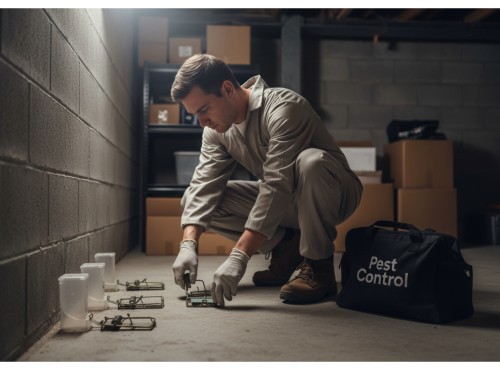Case Studies Combined with Public Health and Regulatory Oversight
Commercial Food Establishment – Queen Street & Bathurst Street
A mid-sized restaurant near Queen Street and Bathurst Street, adjacent to heritage buildings and high pedestrian traffic, experienced recurring Norway rat (Rattus norvegicus) activity in its rear laneway. Prior single-visit exterminations provided only temporary relief.
Upon site assessment by a certified Pest Management Professional (PMP), technicians identified multiple ingress points along aging foundation walls and a defective floor drain acting as a harborage site.
A tailored Integrated Pest Management (IPM) program was introduced:
- Tamper-resistant bait stations placed along established runways.
- Mechanical snap traps for interior containment.
- Use of a microencapsulated formulation (ME) rodenticide, chosen for its extended residual effect under damp conditions.
- Exclusion work with steel wool and cement patching.
After 30 days, activity decreased by 92%, verified through trend analysis and monitoring device data. Toronto Public Health’s Food Premises Safety Program later issued a compliance clearance, reinforcing the value of preventive follow-ups and documented pest control logbooks.
Residential Home – High Park North
A detached home near High Park North presented nocturnal scratching noises within the attic void. The homeowner, initially attempting DIY trapping, observed minimal success.
Upon visual inspection and pest ID, technicians discovered commensal house mice (Mus musculus) entering through weep holes near the soffits and utility penetrations around HVAC lines.
The PMP recommended an exclusion-first strategy:
- Sealing gaps using wire mesh and expanding foam rated for rodent-proofing.
- Multi-catch traps positioned within attic voids and basement junction boxes.
- Removal of stored clutter to reduce conducive conditions.
Within two service visits, tracking powder and glue boards showed zero rodent marks. The property was enrolled in a bi-annual preventative service plan consistent with NPMA-recommended threshold monitoring schedules for residential environments in temperate climates.
Institutional Facility – University Avenue & Dundas Street
A downtown Toronto medical facility near University Avenue and Dundas Street reported persistent rodent sightings in its waste handling area. Given the site’s sensitivity as a healthcare account, the control program had to comply with Zero Tolerance Zone protocols and Health Canada PCP rodenticide standards.
Action steps included:
- Load dock entry point analysis using ultraviolet tracking dust to identify access zones.
- Installation of tamper-proof stations with non-repellent baits to prevent interference with hospital operations.
- Coordination with Facilities Management to implement waste container rotation and eliminate overfilled dumpsters.
The PMP employed rodenticide applications with minimal Restricted Entry Intervals (REI) and ensured WHMIS-compliant documentation was accessible on-site.
Follow-up inspections over 90 days showed complete elimination of sightings, with data-logged bait consumption reports shared directly with the hospital’s infection control team.
Multi-Unit Residential Complex – Parliament Street & Dundas Street East
A 40-unit apartment building near Parliament Street and Dundas Street East suffered chronic rat migration from nearby alleyways. The complex’s aging foundation walls and garbage storage area created a constant attractant.
The PMP performed a crack and gap survey, locating multiple harborage zones behind deteriorating brickwork. The control strategy included:
- Installation of rodent bait stations around the perimeter with rotation of active ingredients (in compliance with Health Canada PCP Number 30642 guidelines).
- Foam exclusion applied to basement bulkhead seams.
- Introduction of IPM community engagement sessions, teaching residents to secure waste, report activity, and prevent secondary pest attraction (e.g., cockroaches).
A collaborative follow-up with Toronto Community Housing and City of Toronto By-law Enforcement confirmed substantial improvement within two months. A service logbook maintained by the property manager satisfied Municipal Code Chapter 548 – Littering and Dumping of Refuse inspection requirements.
These four Toronto case studies, spanning commercial kitchens, heritage homes, healthcare sites, and residential complexes, demonstrate that effective rodent management depends as much on regulatory compliance as it does on technical skill.
When PMPs align their service protocols with public health requirements, maintain audit-ready documentation, and prioritize structural exclusion, they not only control infestations but also reinforce the city’s collective effort toward sustainable urban sanitation.
A compliant program is, in essence, an effective one. Toronto’s integrated regulatory landscape continues to illustrate that best-in-class pest management is built on science, structure, and accountability.
Public Health and Regulatory Oversight
Municipal Oversight: Toronto Public Health and City By-laws
- The City of Toronto Public Health (TPH) enforces sanitation and pest control under the Health Protection and Promotion Act (R.S.O. 1990).
- Active monitoring occurs in high-density districts such as Kensington Market, Chinatown, and Queen Street West, where food waste and laneway infrastructure attract rodent populations.
- Businesses cited for infractions must provide proof of professional pest control contracts and documentation of corrective actions.
Provincial and Federal Oversight
All pest control operations in Ontario must align with:
- Ontario Regulation 63/09 under the Pesticides Act (R.S.O. 1990) – requiring licensed structural applicators.
- Health Canada’s Pest Management Regulatory Agency (PMRA) – ensuring all rodenticides carry valid PCP registration numbers.
- WHMIS 2015 standards – guaranteeing SDS (Safety Data Sheets) are available for on-site review.
- Canadian Environmental Protection Act (CEPA) – limiting environmental exposure to anticoagulant rodenticides.
Industry Standards and IPM Alignment
The Canadian Pest Management Association (CPMA) and NPMA advocate for Integrated Pest Management (IPM) models as the gold standard in urban rodent control. Toronto’s municipal programs mirror these practices, emphasizing:
- Threshold monitoring before chemical use.
- Habitat modification and exclusion measures.
- Documentation of corrective actions and measurable outcomes.









